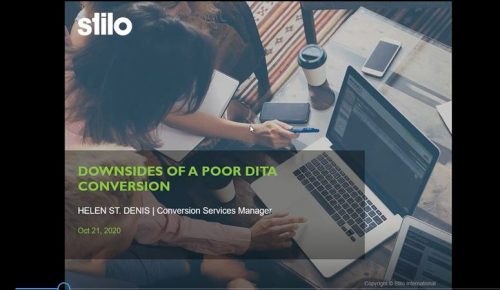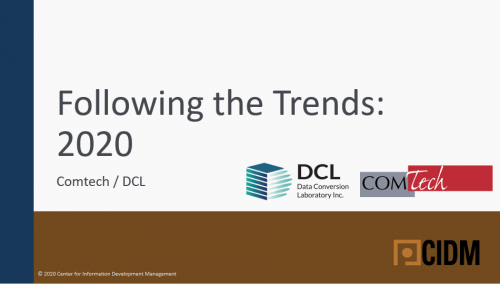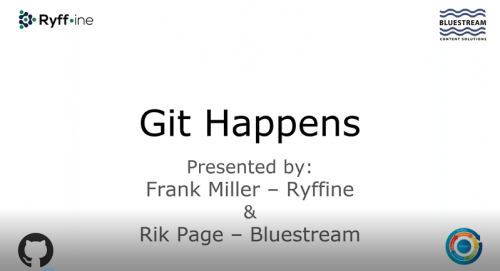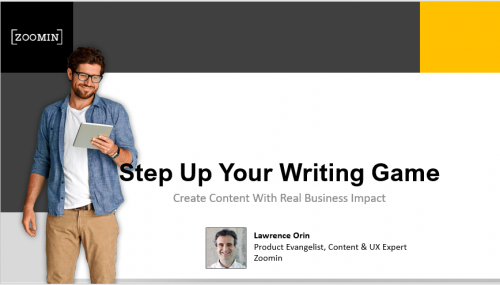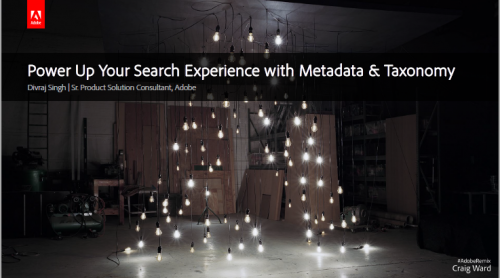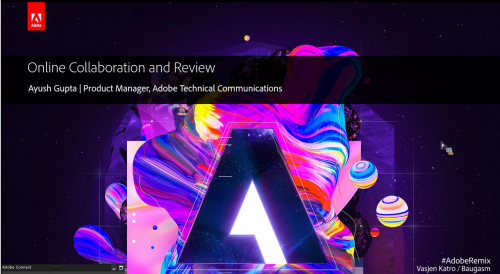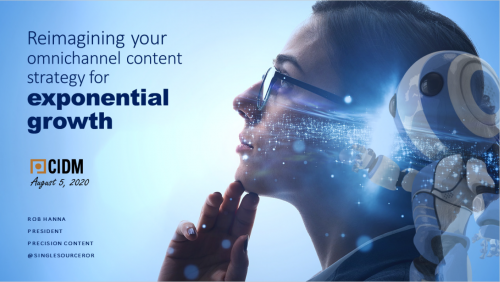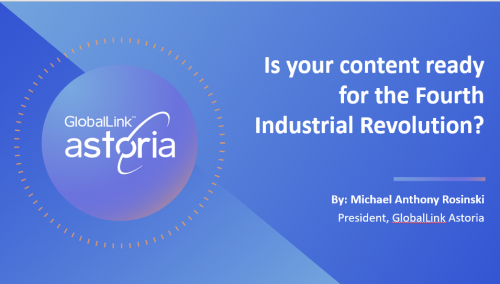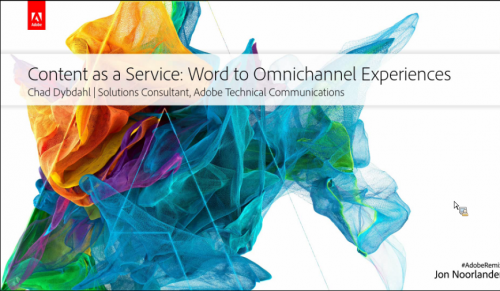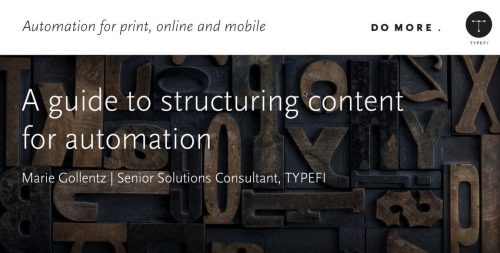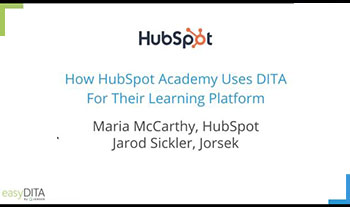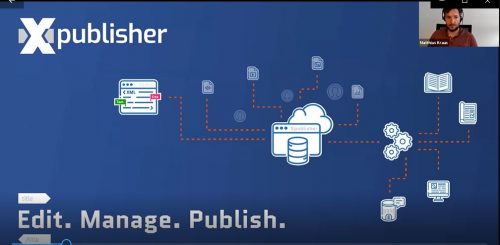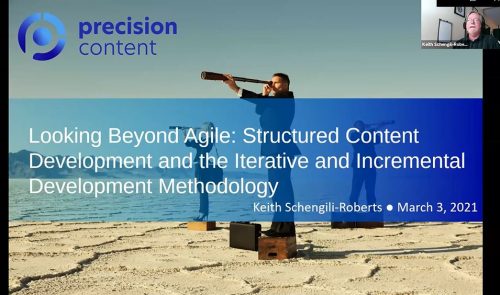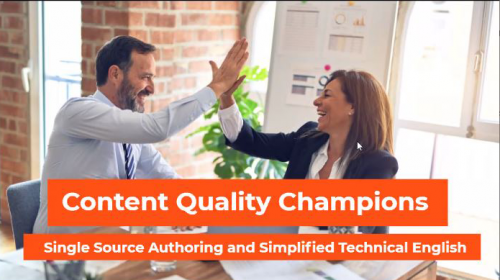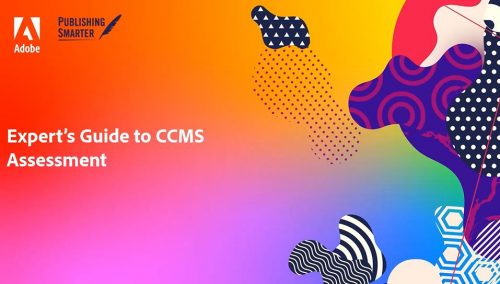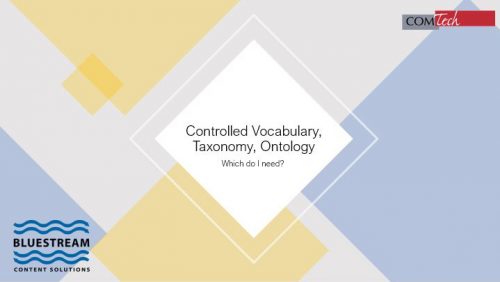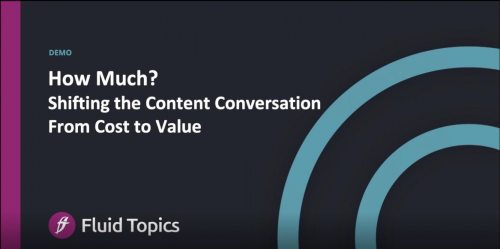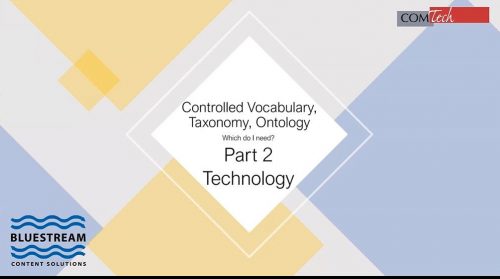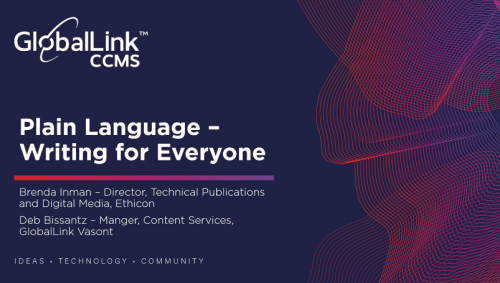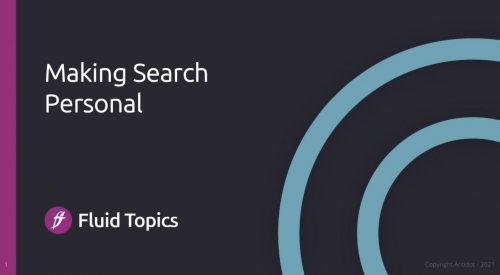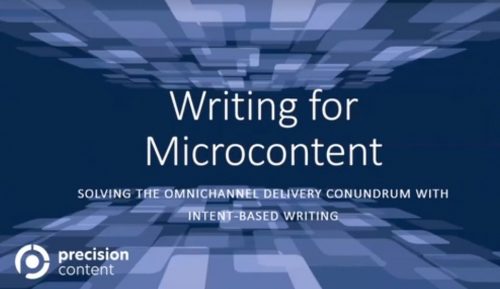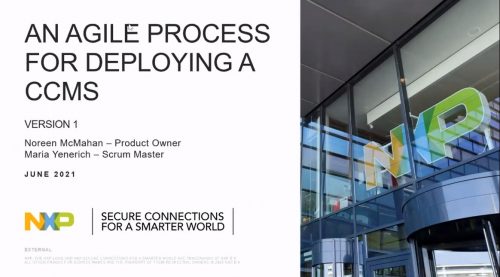-
October 21, 2020 Thinking of automating your entire conversion process to DITA? Wanting to handle conversion work manually, in-house? Before you proceed, think about how the conversion could help you derive the benefits of DITA that you expect. A simplistic approach may allow you to publish something that looks just like what you have now. But a really good quality conversion will help you to leverage content reuse, personalization and multi-channel publishing, as well as making it easier to maintain and update your content. For example, will your conversion generate keys and keyrefs for variables? How about a relationship table, to prevent broken links? Will menu cascades be correctly marked up, for localization purposes? Presented by: Helen joined Stilo as a technical editor. She now works closely with Stilo Migrate customers, helping them to analyze their legacy content and configure appropriate mapping rules. She also provides Migrate customer training and support. Helen has helped Migrate customers to convert tens of thousands of pages of content to DITA and custom XML. Helen holds a Bachelor of Arts in English from St. Francis Xavier University in Antigonish, Nova Scotia, and has pursued graduate studies at Queen’s University in Kingston, Ontario.
-
May 12, 2020 In its eighth year of collecting data, the Center for Information-Development Management (CIDM) and Data Conversion Laboratory (DCL) asked managers, information architects, writers, training developers, and more how they are addressing the challenges of meeting customer information needs. During the webinar we walk through the results of the 2020 Trends Survey, a study we have been conducting since 2012. We trace the changes in how we think about developing and delivering content. Learn how others in the information-development community are planning to respond to new customer demands for innovative approaches to development and delivery. Presented by: Dawn Stevens, President, Comtech Services and Director of CIDM has 28 years of practical experience in virtually every role within a documentation and training department, including project management, instructional design, writing, editing, and multimedia programming. Dawn is the perfect advisor to identify and remove the challenges you face in producing usable, technical information and training content. With both engineering and technical communication degrees, Dawn combines her solid technical foundation with strong writing and design skills to lead our team of consultants and specialists in providing the expertise you need. Mark Gross, President, Data Conversion Laboratory, is a recognized authority on XML implementation and document conversion. Mark also serves as Project Executive, with overall responsibility for resource management and planning. Prior to joining DCL in 1981, Mark was with the consulting practice of Arthur Young & Co. Mark has a BS in Engineering from Columbia University and an MBA from New York University. He has also taught at the New York University Graduate School of Business, the New School, and Pace University. He is a frequent speaker on the topic of automated conversions to XML and SGML.
-
June 16, 2020 Unlike a decade ago, organizations face few barriers to entry if they want to develop structured content in a DITA-based ecosystem. The increasing adoption of Git as a content platform, and the maturing of DITA-focused products like oXygen have removed many of the cost barriers to implementing DITA in an elegant and scalable way. Whether a stop on a longer-term transition to a CCMS or the final destination, a mostly open-source DITA tool chain can be a valuable proving ground for a sophisticated content strategy. In this presentation, you’ll learn how process, information design, scalable repository design, and smart use of oXygen and Git can be more than a short-term solution. You will also learn where Git falls short and when you should be using a DITA CCMS. Presented by: Frank Miller president/ founder of Ryffine is an industry thought-leader whose career has focused on leading enterprise client engagements and building an information development community, Frank has been involved in dozens of successful DITA implementations. In addition to partnering with many leading names in the information development and content management spaces, Frank enjoys sharing his insights on trends and facilitating the adoption of best practices throughout the community. Presented by: Rik Page is EMEA Sales and Marketing Director at Bluestream Software and has been working with both component content and document management solutions since 200. During this time, he has worked with custom DTDs and Schemas, S1000D, iSpec2200 and since 2005 DITA. Rik's practical experience ranges from data capture/content creation through to dynamic multichannel delivery. This has been achieved in a wide range of industries including banking and finance, manufacturing, central government, and education. A keen advocate of technology and innovation Rik has taken part in multiple consultancy projects and helped formulate solutions all over the world.
-
June 3, 2020 In these difficult times, it’s absolutely critical to demonstrate your value to your organization. As a technical communicator, your mission is to make sure you’re getting the right information to the right people. Part of the solution is to find the right tools – but they will only take you so far. Good content is crucial. You must write content in a way that best suits your audience and best matches their search patterns, so they can organically surface the information they need. Join Lawrence Orin, Product Evangelist and Customer Implementation Expert at Zoomin, as he takes an intriguing look at content strategy, and reveals a down-to-earth, practical approach that will ensure your writing is making a visible impact on your company. In it this webinar, you’ll learn:
- Practical steps to improving your writing skills
- Best practices for structuring content
- How to tailor your writing to your audience
-
May 13, 2020 There is an explosion of content today. But what makes your content stand out is – relevance and searchability. To ensure that customers don’t have to spend hours searching through your content, metadata is key. And to know what metadata to add while authoring, a well-established taxonomy is key. To design a truly best-in-class content search experience metadata and taxonomy need to work in tandem. In this webinar we will showcase:
- How to leverage metadata to make your content searchable
- What is the difference between good and bad taxonomies
- A live example of taxonomy development using Adobe Experience Manager
-
June 10, 2020 Abstract World has seen a very different modus operandi in the last couple of months. This only emphasizes the fact that collaborating without physically being in the same space is fast becoming the norm where team members are either located in different geographical locations or are working from home. At this time, a smooth review and collaboration process for technical content can be a real boon to your organization. In this session, Ayush Gupta, Product Manager at Adobe, will discuss how organizations can transform their mundane, time consuming and cyclic review process into a more meaningful, error-free and productive collaboration experience for Content Creators and Subject Matter Experts (SMEs). Key takeaways:
- Why rethink about current review processes
- What are the benefits of adopting online review process for DITA content
- What are the basic tenets and features of an online review process
- A walkthrough of a typical collaborative review workflow and how to make it an experience for business users
-
August 5, 2020 Abstract Business leaders around the globe are looking for ways to replicate the successes of innovative and disruptive organizations like Uber, Amazon, and Spotify that grow exponentially. Rather than adding 10%, they’re looking for 1000%. Exponential growth is deliberate and involves organizations developing capabilities that dramatically outperform the competition. Rob Hanna explores how information-enablement across the enterprise is key to this type of performance and why we need to rethink how we create content to become Exponential Organizations. What you’ll learn
- The definition of “information enablement”
- How your content is tied to your brand’s ability to grow exponentially
- How the 4th Industrial Revolution will impact global businesses, including yours
-
July 15, 2020 The Fourth Industrial Revolution, sometimes described as the perfect storm of new technologies combined with the asteroid of digital information, has forced companies to adopt new organizational structures to create and distribute content. This presentation will define the new exponential organizations, companies that grow often at 10 times faster than comparable companies, and are guided by a massive transformational purpose to deliver Information Enablement through innovations such as “Content as A Service” – CAAS. Presented by: Michael Rosinski has lead a successful career as a technology executive in the enterprise software industry. Presently, Michael is President of Astoria Software which is the premier CCMS – Component Content Management System in the Technical Product Documentation Vertical. At Astoria, he was first to market to launch the Enterprise SaaS Model and Mobility Platforms. Michael merged the Goldman Sachs venture to TransPerfect, the largest private translation company in the world. Prior to Astoria, Michael was a founding member of American Software’s management team, grew revenues to $ 100M+ and made it to the Forbes Best 200 Small Companies in America list. At American, Michael completed one of the first IPO’s in the ERP market, and later contributed to the successful spin off IPO of Logility in the Supply Chain Management Space. Michael leveraged his international experience as President of Augeo Software, a French/Dutch company in the PSA Professional Automation Space where Computerworld designated them as one of “The Top 100 Companies to Watch” Michael also held Management positions at Johnson & Johnson and Nestle.. Michael holds a Bachelors Degree in Management and Organizational Behavior at Rider University, and has completed MBA study at Fairleigh Dickinson University.
-
Date: August 12, 2020 Squatches, yeti, and kraken: oh, my! Learn about cryptozoology, cryptids, and… oh yes: the future of content strategy and digital experiences. Chad Dybdahl, Adobe Solutions Consultant, walks you through importing content from Microsoft Word, creating intelligent, structured content that can then be used across a wide range of delivery channels and platforms. In this session, we’ll see both traditional and headless delivery strategies that will inspire you to think about content in new and exciting ways.
- Strategies to repurpose your technical content in new ways
- Headless content delivery: what is it and why you need it
- Creating structure from (MS Word) chaos
-
September 9, 2020 This is a presentation that provides an intersection between content and design. It is a high-level practical guide to analyzing your content, deciding what you want to do with it, developing style naming conventions, and developing editorial style guides, design style guides, and style templates. Once you get to that stage, you can then consider how content management systems, automation, and xml might fit into your publishing processes. Presented by: Marie Gollentz is a Senior Solutions Consultant focusing on the European market. Prior to joining Typefi, she held a number of positions in the publishing industry in London, including at the publisher of Research Fortnight and the London School of Business and Finance. Marie holds a Masters degree in European Political Sciences from the Autonomous University of Barcelona and a Bachelor’s degree in Political Sciences from Sciences Po Strasbourg. She is trilingual in English, French and Spanish.
-
August 10, 2020 Content developers and managers worldwide are coming together to share ideas and inspire each other at ConVEx in September. When first announced, we said ConVEx is not an online simulation of an in-person conference, but an immersive experience designed from the ground up to use our e-resources in the best possible way to bring you a wealth of ideas and information to support your efforts in defining and executing a comprehensive content strategy. During this Webinar, Dawn Stevens explains what we mean by this statement and what you can expect and gain from this new event format. We'll discuss the event format, the technology we'll use, and highlight the many networking activities provided. By the end of the Webinar, you'll know why you should attend ConVEx — it's an opportunity to have a positive experience, converge with others in the industry, focus your attention on industry issues, and magnify your value to your organization. Presented by: Dawn Stevens, President, Comtech Services and Director of CIDM has 28 years of practical experience in virtually every role within a documentation and training department, including project management, instructional design, writing, editing, and multimedia programming. Dawn is the perfect advisor to identify and remove the challenges you face in producing usable, technical information and training content. With both engineering and technical communication degrees, Dawn combines her solid technical foundation with strong writing and design skills to lead our team of consultants and specialists in providing the expertise you need.
-
November 18, 2020 Learn how HubSpot Academy, the world’s leader in providing inbound sales, marketing and customer service education, adopted DITA to help solve their content creation, conversion and output needs. HubSpot’s use case is exciting and unique as it pushes the boundaries of what we typically associate with DITA. Rather than producing typical technical documentation, HubSpot is using DITA to produce:
- Complete lessons, courses, and certifications
- Learning assessments
- Powerpoint outputs
- And localizing that content in five languages
-
March 17, 2021 Xeditor is a professional online XML editor based on state-of-the-art web standards. With Xeditor, structured, semantically correct content in XML format can be created intuitively, efficiently and without technical knowledge. By enabling authors to work together on structured content from any location at any time, Xeditor helps companies put efficient workflows in place. This way, companies are able to take advantage of all the benefits of standardized content - such as automated further processing - without the need for costly training for authors. Presented by: Matthias Kraus is the founder and managing director of Xpublisher GmbH. Since 2001, he has been advising numerous leading international companies and organizations from the aerospace, technology, education, publishing, public administration and many other industries in the field of multi-channel publishing and accompanying them on their way to digitization.
-
March 3, 2021 This webinar is free. Agile development makes specific demands on documentation teams, whose content creators need to be nimble, describe features in a piece-meal fashion, and find ways to report on their content development progress. Structured content is ideally suited to these needs. But experience has shown that some teams find it hard to move fully to an Agile methodology, often using an uneasy mix of waterfall and Agile processes. Precision Content’s Keith Schengili-Roberts will talk about the current state of Agile and structured content, and also give an introduction to the Iterative and Incremental Development (IID) methodology, a recent Agile offshoot that works well for technical writing teams. If you are wondering about what the impacts are of working with Agile or are simply looking to optimize your DITA-based documentation processes, this presentation is for you! Presented by: Keith Schengili-Roberts is a Content Specialist and Information Architect at Precision Content. Keith is also an award-winning lecturer on Information Architecture at the University of Toronto’s Faculty of Information, and the Chair of the OASIS DITA Adoption Committee. He is also the writer behind the “DITAWriter.com” website, which has long been a useful resource for those working with the DITA XML standard. He lives in the north end of Toronto with his long-time girlfriend Dhan and her two noisy green-cheeked conures.
-
March 31, 2021 How do you ensure that your content is consistent and follows your brand’s guidelines? How do you begin a project that’s consistent across your technical communications? Is it an achievable goal? What results should I expect? In this webinar, learn how the combination of easyDITA's CCMS and HyperSTE allows you to check your content against your specific style guide, as well as industry standard grammar and terminology rules. The result is not only scalable and single-sourced content, but clear and concise content across the board. Content that's more cost effective, brand aligned, and ready to attract new customers. Attendees will learn:
- The value of combining an XML CCMS with a Grammarly-like content checker
- A live demo of easyDITA with HyperSTE that shows how the tools work together to help content creators
- A general project plan to help you get started in achieving great results
- An example of a customer implementation and their results
-
March 24, 2021 Every organization has different content management needs. The needs can be pretty broad or hyper-focused. Everybody has different expectations around the user interface, but the underlying requirements are always based on rich capabilities around legacy content ingestion, authoring, metadata management, storage, delivery, and more. Developing a content strategy is crucial to the success of your CCMS project. Core components help focus your questions, create detailed use cases, and identify candidate departments and content to help assess a CCMS. When you start a CCMS assessment, you should have a comprehensive set of parameters to guide you. It is very important to make the proper discovery and choose the solution which is the right fit. Otherwise, energy is expended to force-fit a solution which usually leads to frustration and wasted resources. Join Divraj Singh, Sr. Solutions Consultant at Adobe, in a conversation with Bernard Aschwanden, CEO at Publishing Smarter, whose organization has done multiple CCMS migrations, to understand the following parameters which will make a CCMS evaluation process easy. They will be leveraging Adobe’s CCMS solution –XML Documentation for Adobe Experience Manager, to showcase some of these workflows.
- What difference does authoring standard make (unstructured, XML, DITA, HTML etc.)?
- How advanced are the content management capabilities (web vs offline, metadata support, advanced search)?
- How does the solution provision for storage (versioning, DAM capabilities etc.)?
- What OOTB workflows does the solution support (review, translation, task management, content ingestion, etc.)?
- What reporting capabilities does it have?
- What publishing capabilities does it provide(DITA OT, integrated tools, third-party plug-ins)?
- How extensible is the solution (APIs, DITA specializations, integration with external systems)?
Bernard Aschwanden is the Founder of Publishing Smarter. Bernard Aschwanden and his company Publishing Smarter help clients reduce costs and improve the quality of content. A past President of the Society for Technical Communications, he trains, writes, and presents on communications, publishing, and single-source reuse. Publishing Smarter helps companies automate content processes to publish better, faster, and smarter and provide a maximum return on investments. Bernard on LinkedIn: https://www.linkedin.com/in/bernardaschwanden/ Bernard on Twitter: https://twitter.com/aschwanden4stc https://twitter.com/publishsmarter Website -
March 9, 2021 Ironically, the terms utilized to describe a vocabulary of words used to organize and catalog information within a content corpus often are used inconsistently or interchangeably. However, each term represents a point, on an increasing scale of complexity and resulting data richness and applicability. In this two-part webinar, Dawn Stevens of Comtech Services defines key points along this scale, comparing and contrasting the scope and domain to which each term applies, suggesting when each might be used, and recommending the processes for creating it. Dawn is joined by Rik Page of Bluestream, who will demonstrate real-life examples of each in use. Participants will gain clarity about the approach required to make content more accessible for their users. View part 2 of this webinar here. Presented by: Dawn Stevens is the President, and owner of Comtech Services and the Director of the Center for Information-Development Management. With over 25 years of experience, including 20 years at Comtech, Dawn has practical experience in virtually every role within a documentation and training department, including project management, instructional design, writing, editing, and multimedia programming. With both engineering and technical communication degrees, Dawn combines a solid technical foundation with strong writing and design skills to identify and remove the challenges her clients face in producing usable, technical information and training. Rik Page is Sales and Marketing Director at Bluestream Software and has been working with both component content and document management solutions since 2001. During this time, he has worked with custom DTDs and Schemas, S1000D, iSpec2200 and since 2005 DITA. His practical experience ranges from data capture/content creation through to dynamic multichannel delivery, achieved in a wide range of industries including banking and finance, manufacturing, central government and education. A keen advocate of technology and innovation Rik has taken part in multiple consultancy projects and helped formulate solutions all over the world. Away from the office Rik is a Scout Leader working with young people and helping them to develop new skills whilst having fun.
-
April 14, 2021 Unsurprisingly, when it comes to the money your company spends producing technical documentation, your management knows the cost down to the penny. And when it comes to investing in THE content delivery solution that will streamline your work process, unleash your content, and transform your user experience, one question will arise without a doubt: “How much?” Meaning: “How much will it cost?" This can be a completely different conversation if you can turn it into “how much it will save” and “how much additional revenue it will bring to the company." In this webinar, we will give you a clear picture of the cost savings and gains a content delivery platform such as Fluid Topics can generate across three areas: customer and partner service, employee productivity, and client satisfaction. We will also give you access to a tool that will help you navigate scenarios and determine how long it will take to achieve a return on your investment by customizing the calculator’s numbers to fit your situation. Presented by: Geraldine Boulez is passionate about new technologies and their ability to solve people and business problems. This is what has led her to product management, marketing and business development positions in fast-growing tech companies and innovative corporations for over twenty years. Geraldine is VP of Marketing at Fluid Topics, the leading Content Delivery Platform that reinvents how users search, read and interact with technical documentation.
-
April 6, 2021 Ironically, the terms used to describe a vocabulary of words that organize and catalog information within a content corpus are often used inconsistently or interchangeably. However, each term represents a point on an increasing scale of complexity and resulting data richness and applicability. Following Part 1 of this webinar in which Dawn Stevens of Comtech Services defined and compared these points along the taxonomy spectrum (view part 1 recording), Rik Page of Bluestream now demonstrates the technology and tools that enable you to define and manage your terms and relationships, as well as those that consume what you have defined. Participants will see practical, real-life applications of the taxonomical concepts previously presented. Click here to download the reading list referenced during this webinar. Presented by: Dawn Stevens is the President, and owner of Comtech Services and the Director of the Center for Information-Development Management. With over 25 years of experience, including 20 years at Comtech, Dawn has practical experience in virtually every role within a documentation and training department, including project management, instructional design, writing, editing, and multimedia programming. With both engineering and technical communication degrees, Dawn combines a solid technical foundation with strong writing and design skills to identify and remove the challenges her clients face in producing usable, technical information and training. Rik Page is Sales and Marketing Director at Bluestream Software and has been working with both component content and document management solutions since 2001. During this time, he has worked with custom DTDs and Schemas, S1000D, iSpec2200 and since 2005 DITA. His practical experience ranges from data capture/content creation through to dynamic multichannel delivery, achieved in a wide range of industries including banking and finance, manufacturing, central government and education. A keen advocate of technology and innovation Rik has taken part in multiple consultancy projects and helped formulate solutions all over the world. Away from the office Rik is a Scout Leader working with young people and helping them to develop new skills whilst having fun.
-
April 21, 2021 The Plain Writing Act of 2010 requires federal agencies to follow plain language guidelines for government documentation. In addition, Section 508 standards require all information and communications technology to be accessible to disabled users. Besides meeting these requirements, are there other advantages for technical writers who use plain language? Yes, there are! Brenda Inman and Deb Bissantz will explore examples of overly verbose information that can be written using plain language to convey the information more clearly. While exploring these examples, Brenda and Deb will also share benefits, guidelines, and tips for using plain language. What can the audience expect to learn? Attendees will learn to recognize opportunities for using plain language, such as when to use a $0.50 word instead of a $5.00 word. Attendees will also learn tips for writing clear, concise information using plain language. Presented by: Deb Bissantz is a Content Services manager for GlobalLink CCMS. Deb’s mission is to partner with organizations to make the most of their DITA and component content management solutions. Before joining GlobalLink CCMS, Deb worked with and authored DITA content for many years. As a writer and tools administrator, she helped several organizations migrate technical documentation to DITA and to a CCMS. Deb is a voting member of the DITA Technical Committee. Brenda Inman is the Director of Technical Publications for Robotics and Digital Solutions at Ethicon, part of the Johnson & Johnson family of companies. Brenda has worked in the medical device her entire career mostly within technical publications and localization and also has experience in clinical research and regulatory affairs. Brenda’s experience within technical publications and localization includes writing user manual content, implementation of content management systems, and setting up best practices for writing and localization.
-
May 26, 2021 What if the search function on your tech doc was providing personalized results and was as good as Google, reading the mind of your users and anticipating their needs? What about a search engine that learns and gets more accurate, more relevant and personal every day. What does it take to get there? It’s mostly about technology, but not only. It also requires information: about your content (metadata) and about your users (profiles). In this Webinar, we will introduce the challenges, review the possible solutions, and discuss what you need to have and do in order to support this shift to a modern user experience. Presented by: Fabrice Lacroix is a serial entrepreneur and a technology pioneer. He has been working for 25 years on the development of innovative solutions around search technology, content enrichment and AI. He is the founder of Fluid Topics, the leading Content Delivery Platform that reinvents how users search, read and interact with technical documentation.
-
June 2, 2021 Various surveys are showing that the majority of the world’s leading companies have accelerated their digital transformation efforts during the pandemic – efforts that are not slowing down. This presentation will discuss the key role content plays in the field of digitalization, and what you should do to future proof your content while elevating your customer experience. Presented by: Berry Braster has been in the technical documentation field for over 18 years and has helped implement content strategies, including the use of DITA and HyperSTE controlled language software. As Technology Director, Berry is involved with connecting technical documentation to IoT, and how to leverage on technologies like Augmented and Virtual Reality.
-
May 19, 2021 Omnichannel experience is setting the bar for customer expectation and it’s putting new and increasingly complex demands on your business to deliver the right information where your customers need it. Writing for the web is not writing for omnichannel. Preparing your content for emerging technologies requires new approaches to content creation and delivery. It requires a microcontent strategy. Robust content management technology is certainly part of the solution, and your organization will be tempted to invest in new tools for chatbots and voice. However, before you go ahead and fill yet another content silo with zettabytes of information, instead make enhancements to the content creation programs you already have. Microcontent is the next evolution in structured authoring and will open new channels for your content while improving delivery across existing channels. In this session, we will focus on the missing link in a successful microcontent strategy: an intent-based writing methodology. We will highlight some key concepts that will help you to start looking at your content through an omnichannel lens. Presented by: Mike Rowlinson is the VP of Training & Content Services at Precision Content. Mike has been working in the technical communications industry since 2005. His core belief is that great content enables great companies. Mike’s division develops and delivers engaging and effective training and transformation engagements including the recent completion of the firm's eLearning product, the 15 modules self-paced, Precision Content® Writer Training. The training enables writers to create effective content so that staff and customers alike can find what they need and understand what's required quickly and efficiently.
-
June 30, 2021 NXP successfully deployed a DITA CCMS in 2016, in a SaaS environment, to manage technical product documentation. A software and system upgrade to Tridion Docs 14 (CCMS) was planned in 2019-20 to take advantage of new capabilities, performance improvements, system and infrastructure updates. Managing a successful CCMS upgrade requires detailed coordination, planning, testing, communication, and execution. From the webinar, you will learn how NXP effectively utilizes SAFe methodologies, together with their CCMS vendor RWS, to manage and execute the upgrade. Noreen and Maria worked together to coordinate activities on an NXP Agile Release Train (ART) as both are SAFe-certified. Noreen heads the RWS core team, which consists of representatives from several NXP business lines. Maria is from IT, working as the upgrade project Scrum Master. Overall, the upgrade was a success, as it was completed on time and within budget. NXP did encounter some unexpected issues that were managed following this process. During this webinar, Noreen and Maria will discuss how the business and IT benefited by utilizing SAFe methodologies to document CCMS configurations, develop and execute test cases for upgrade testing, managed communications with RWS and third-party vendors, communicated benefits to the business users, and moved all users into an upgraded production system with minimal interruptions. Presented by: Maria Yenerich works as a Scrum Master within the NXP Marketing Information Technology (IT) group. With 20+ years of system management experience, Maria has an undergraduate degree from Creighton University and a Master’s of Business Administration from the University of Illinois. Noreen McMahan has a Ph.D. from the University of Texas in Austin. In 2008, Noreen joined a team deploying a new CCMS in a global company. For almost a decade, she trained users of the CCMS around the world. She authored the online training in the DITA environment using the same tools as the writers and engineers she trained. She began her role as NXP RWS Product Owner after working on a team that deployed SDL LiveContent Architect as the new NXP CCMS in 2016. Later, as the 2020 pandemic gained momentum, Noreen worked on an Agile team that successfully completed an RWS upgrade of the CCMS to Tridion 14. She, therefore, has experience in deploying a new CCMS and in upgrading an existing one. Chip Gettinger is VP Global Solutions Consulting at RWS, managing a team that works with customers in maximizing global content with RWS. He has experience working with customers to develop global content strategies, business ROI adoption drivers, change management, and technology adoption for component content management systems. He speaks and blogs about customer successes working closely with industry standards, partners, and customers in technology solutions and deployments.

